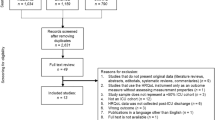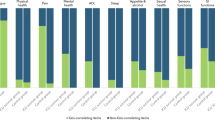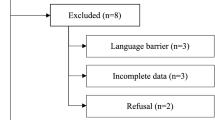Abstract
Objective
Development and validation of quality of life questionnaire for critical care patients.
Design
Prospective study.
Setting
Intensive care unit (ICU) of a general hospital and ICUs of 83 Spanish hospitals.
Sample
Patients admitted to the ICU>18 years of age; close family members.
Method
A committee of experts designed a questionnaire with characteristics judged essential for intensive care use: easy, quick administration (5–10 min); capable of completion by patient or close family member, by direct or telephone interview. Fifteen items relevant to critical care patients were grouped in three subscales: basic physiological activities, normal daily activities, and emotional state. Reproducibility of interobserver, intraobserver, patient/family member and telephone/direct interviews was analysed and also internal consistency, responsiveness, and main components.
Results
Internal consistency (578 patients): Cronbach's alpha coefficient=0.85. Reproducibility: intraobserver reproducibility (n=150): Spearman correlation coefficient=0.92. Interobserver (n=85); correlation=0.92. Patient/family member (n=81): correlation=0.92. Telephone/direct interview (n=54): correlation=0.96. Validity: factorial analysis confirmed that the three subscales were fundamental questionnaire components. There was good concordance between questionnaire/subscale and Glasgow Outcome Scale (GOS) results. Responsiveness: quality of life score changes between preadmission and 6 months' postdischarge correlated with GOS findings (weighted kappa index=0.56).
Conclusions
Questionnaire meets objectives recommended for critical care use, and fulfills essential requirements of validity and reproducibility when applied to critically ill patients.
Similar content being viewed by others
References
Knaus WA, Zimmerman JE, Wagner DP, Draper EA, Lawrence DE (1981) APACHE — Acute Physiology and Chronic Health Evaluation: a physiologically based classification system. Crit Care Med 9:591–597
Knaus WA, Draper EA, Wagner DP, Zimmerman JE (1985) APACHE II: a severity of disease classification system. Crit Care Med 13:818–829
Knaus WA, Wagner DP, Draper EA, Zimmerman JE, Bergner M, Bastos PG, Sirio CA, Murphy DJ, Lotring T, Damiano A, Harrell FE (1991) The APACHE II prognostic system. Risk prediction of hospital mortality for critically ill hospitalized adults. Chest 100:1619–1636
Le Gall JR, Loirat P, Alperovitch A, Glaser P, Granthil C, Mathieu D, Mercier P, Thomas R, Villers D (1984) A simplified acute physiology score for ICU patients. Crit Care Med 12: 975–977
Le Gall JR, Lemeshow S, Saulnier F (1993) A new simplified acute physiology score (SAPS II) based on a European/North American multicenter study. JAMA 270:2957–2963
Teres D, Lemeshow S, Aurunin JS, Pastides H (1987) Validation of the mortality prediction model for ICU patients. Crit Care Med 15:208–212
Lemeshow S, Teres D, Klar J, Avrunin JS, Gehlbach SH, Rapoport J (1993) Mortality probability models (MPM II) based on an international cohort of intensive care unit patients. JAMA 270: 2478–2486
2nd European Consensus Conference on Intensive Care Medicine (1994) Predicting outcome in ICU patients. Intensive Care Med 20:390–397
Spanish Group for Epidemiological Analysis of Critical Patients (PAEEC) (1994) Quality of life: a tool for decision-making in the ICU. Intensive Care Med 20:251–252
Ikegami N (1995) Functional assessment and its place in health care. N Engl J Med 322:598–599
Katz S (1987) The science of quality of life. J Chron Dis 40:459–463
Bowling A (1992) Measuring health: a review of quality of life measurement scales. Open University Press, Philadelphia
Vázquez Mata R, Rivera Fernández R, González Carmona A, Delgado-Rodriguez M, torres Ruiz JM, Raya Pugnaire A, Aguayo de Hoyos E (1992) Factors related to quality of life 12 months after discharge from an intensive care unit. Crit Care Med 20: 1257–1262
Rivera Fernández R, Vázquez Mata G, González Carmona A, Torres Ruiz JM, Delgado-Rodríguez M, Abizanda Campos R, Raya Puignaire A (1991) Descripción de una encuesta de calidad de vida en Medicina Intensiva. Med Intensiva 15:313–318
American Educational Research Association, American Psychological Association, and National Council on Measurement in Education (1985) Standards for educational and psychological testing. American Psychological Association, Washington, DC
Katz S, Ford AB, Moskowitz RW, Jackson BA, Jaffe MW (1963) Studies of illness in the aged. JAMA 185:914–919
Cronbach LJ (1951) Coefficient alpha and the internal structure of tests. Psychometrika 16:297–334
Jenett B, Bond M (1975) Assessment of outcome after severe brain damage. Lancet I:480–484
Walker SR, Rosser RM (1988) Quality of life: assessment and application. MTP Press, Lancaster, UK
Bergner M, Bobbit RA, Carter MB, Gilson BS (1982) The sickness impact profile: development and final revision of a health status measure. Med Care 19:787–805
Patrick DL, Danis M, Southerland LI, Hong G (1988) Quality of life following intensive care. J Gen Intern Med 3: 218–223
Sage WM, Myer HR, Silverman JF (1986) Is intensive care worth it? An assessment of input and outcome for the critically ill. Crit Care Med 14:777–782
Author information
Authors and Affiliations
Additional information
This study forms part of the PAEEC (Project for the Epidemiological Analysis of Critical Care Patients), and was supported by a grant from the “Fondo de Investigaciones Sanitarias” (F.I.S.-91/0703), and by the Granada University Research Group (Number 3244)
Rights and permissions
About this article
Cite this article
Fernandez, R.R., Sanchez Cruz, J.J. & Mata, G.V. Validation of a quality of life questionnaire for critically ill patients. Intensive Care Med 22, 1034–1042 (1996). https://doi.org/10.1007/BF01699224
Received:
Accepted:
Issue Date:
DOI: https://doi.org/10.1007/BF01699224




